We have to convey our experiences and terror of this massive earthquake and tsunami to the future generations. Preparation for, dealing with, supporting and restoration after the disaster, we can’t let the lessons taught by the Great East Japan Earthquake go to waste, for the bright future of our children.
For tomorrow.
Lessons learned from the earthquake and preparations for the future.
Tsunami Tendenko
In the case of emergency independent thinking and daily training are vital.

Gunma University
[Tsunami Tendenko] is an old saying in Sanriku region. It means that in the time of tsunami even when separated from your parents or children all you have to worry about is going to high ground as fast as possible. When the tsunami came 570 students of Kamaishi Higashi Middle School and Unosumai Elementary School evacuated immediately. Middle school children took the hands of the young ones and helped them to run to the predetermined shelter of “Gozaisho-no-Sato”. However, seeing how the cliff at the back of facility was crumbling everyone evacuated further inland to the welfare shelter. Yet since the tsunami was moving towards it they changed their location again to higher ground at the side of Route 45.
These children saved their own lives by demonstrating independent thinking and being true to “Tendenko” teachings: “do not get trapped in pre-established rules”, “do your best under all circumstances”. These are the fruits of daily disaster prevention education and training. This is the importance of being prepared.
A road to Tohoku’s revitalization begins.
“Leading Project” to restoration has begun.
Wide-area disaster-proof road network supports the industry and boosts local economy. It functions as an evacuation, rescue and emergency transportation route in the times of the disaster. Concerned institutions started a project to “revitalize the disaster area and let its inhabitants move back to normal lives as soon as possible”.

2011.12.23
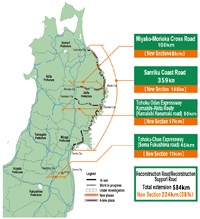

in Tanohata Village, Iwate
2011.11.20
Start of full-scale restoration of river and coastal levees.
Full-scale restoration for Miyagi to help with disaster prevention.
Full-scale restoration of 121 river levees was begun on 11th of November, 2011. About 190 km of total 300 km long coastal levee along Iwate, Miyagi and Fukushima prefectures was seriously damaged. The south Sendai Bay coast was particularly damaged and its restoration was carried out by the national government instead of prefecture as per Miyagi governor’s request. It was the first project of the full-scale restoration measures. The levee was calculated to withstand any tsunami for over hundred years and was set to stand 7.2 m tall. This construction benefited the five municipal governments in the coastal area (Sendai, Natori, Iwanuma, Watari, Yamamoto) as a future disaster prevention measure.
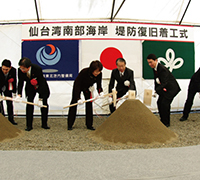
Construction starting ceremony
2012.1.29
Source: the MLIT Tohoku Regional Bureau
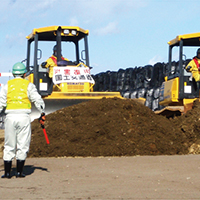
Construction starting ceremony
2012.1.29
Source: the MLIT Tohoku Regional Bureau
Towards restoration, adjustment of levees at the river estuary has made.
Installation of levees at estuary connecting to the coastal levee in order to facilitate the urban development.

Damage Report
Source: the MLIT Tohoku Regional Bureau
Tsunami has reached the Ishinomaki City of Miyagi Prefecture, situated at the estuary of Old Kitakamigawa River, through the first-grade river estuary. The city was even further damaged by a large-scale land subsidence. Because of this an emergency restoration of river levee of five Miyagi coastal first-grade rivers was started immediately. For the full-scale restoration new standards for river levee have been measured so it could withstand floods, storm surges and tsunamis in the future. For restoration purposes the coastal municipalities will keep adjusting the river levee to match the perfect restoration plan for five years following 2011.

Big-size sandbag pile
[Finished as of 25th of June, 2011]
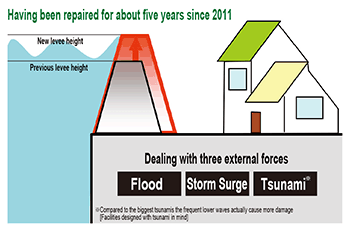
Future possibilities of massive earthquakes.
Another massive earthquake linked to Great East Japan Earthquake is expected in the future.
This time the massive earthquake with hypocenter at Sanriku Sea has caused massive tsunami which brought unprecedented damage to the coastal area along from Aomori down to Chiba prefectures. Looking from history this earthquake could be linked to others and it is expected to see earthquakes at Tokyo metropolitan area, Tokai area, Nankai area, and Tonankai area.
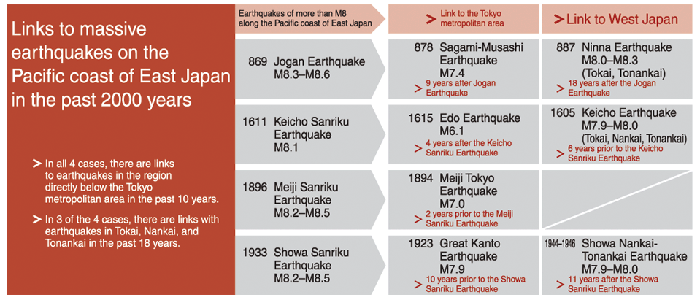
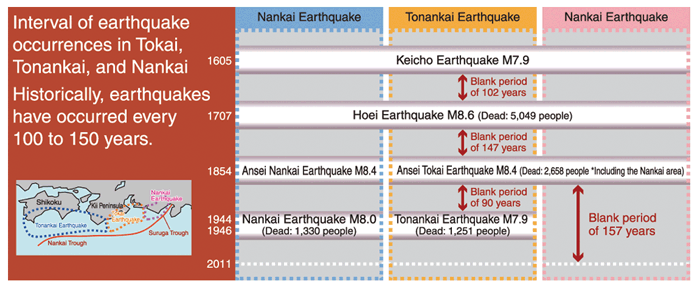
To our children, grandchildren, to the future generations.
We would like to convey the horrors of the earthquake to future generations.
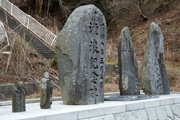
This is a picture of a stone monument standing along Route 45 in Ryoishicho, Kamaishi, Iwate. It tells the horrors of tsunami. The center and the right side monuments were built in 1896, while the left one in 1933. The horrifying tremors of a massive magnitude 9 earthquake. The misery caused by the massive tsunami. We shouldn’t forget this disaster. We have to convey and teach our experiences to our children, the future generations. So that people then will be able to evade this sad fate.
